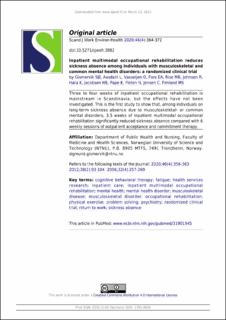| dc.contributor.author | Gismervik, Sigmund Østgård | |
| dc.contributor.author | Aasdahl, Lene | |
| dc.contributor.author | Vasseljen, Ottar | |
| dc.contributor.author | Fors, Egil Andreas | |
| dc.contributor.author | Rise, Marit By | |
| dc.contributor.author | Johnsen, Roar | |
| dc.contributor.author | Hara, Karen Walseth | |
| dc.contributor.author | Jacobsen, Henrik Børsting | |
| dc.contributor.author | Pape, Kristine | |
| dc.contributor.author | Fleten, Nils | |
| dc.contributor.author | Jensen, Chris | |
| dc.contributor.author | Fimland, Marius Steiro | |
| dc.date.accessioned | 2021-03-24T12:34:58Z | |
| dc.date.available | 2021-03-24T12:34:58Z | |
| dc.date.created | 2020-01-20T00:07:17Z | |
| dc.date.issued | 2020 | |
| dc.identifier.citation | Scandinavian Journal of Work, Environment and Health. 2020, 46 (4), 364-372. | en_US |
| dc.identifier.issn | 0355-3140 | |
| dc.identifier.uri | https://hdl.handle.net/11250/2735303 | |
| dc.description.abstract | Objectives This study aimed to investigate whether inpatient multimodal occupational rehabilitation (I-MORE) reduces sickness absence (SA) more than outpatient acceptance and commitment therapy (O-ACT) among individuals with musculoskeletal and mental health disorders.
Methods Individuals on sick leave (2-12 months) due to musculoskeletal or common mental health disorders were randomized to I-MORE (N=86) or O-ACT (N=80). I-MORE lasted 3.5 weeks in which participants stayed at the rehabilitation center. I-MORE included ACT, physical exercise, work-related problem solving and creating a return to work plan. O-ACT consisted mainly of 6 weekly 2.5 hour group-ACT sessions. We assessed the primary outcome cumulative SA within 6 and 12 months with national registry-data. Secondary outcomes were time to sustainable return to work and self-reported health outcomes assessed by questionnaires.
Results SA did not differ between the interventions at 6 months, but after one year individuals in I-MORE had 32 fewer SA days compared to O-ACT (median 85 [interquartile range 33–149] versus 117 [interquartile range 59–189)], P=0.034). The hazard ratio for sustainable return to work was 1.9 (95% confidence interval 1.2–3.0) in favor of I-MORE. There were no clinically meaningful between-group differences in self-reported health outcomes.
Conclusions Among individuals on long-term SA due to musculoskeletal and common mental health disorders, a 3.5-week I-MORE program reduced SA compared with 6 weekly sessions of O-ACT in the year after inclusion. Studies with longer follow-up and economic evaluations should be performed. | en_US |
| dc.language.iso | eng | en_US |
| dc.publisher | NOROSH, Nordic Association of Occupational Safety and Health | en_US |
| dc.rights | Navngivelse 4.0 Internasjonal | * |
| dc.rights.uri | http://creativecommons.org/licenses/by/4.0/deed.no | * |
| dc.title | Inpatient multimodal occupational rehabilitation reduces sickness absence among individuals with musculoskeletal and common mental health disorders: a randomized clinical trial. | en_US |
| dc.type | Peer reviewed | en_US |
| dc.type | Journal article | en_US |
| dc.description.version | publishedVersion | en_US |
| dc.source.pagenumber | 364-372 | en_US |
| dc.source.volume | 46 | en_US |
| dc.source.journal | Scandinavian Journal of Work, Environment and Health | en_US |
| dc.source.issue | 4 | en_US |
| dc.identifier.doi | 10.5271/sjweh.3882 | |
| dc.identifier.cristin | 1777004 | |
| dc.relation.project | Norges forskningsråd: 238015 | en_US |
| dc.description.localcode | This work is licensed under a Creative Commons Attribution 4.0 International License. CC-BY. | en_US |
| cristin.ispublished | true | |
| cristin.fulltext | original | |
| cristin.qualitycode | 1 | |

